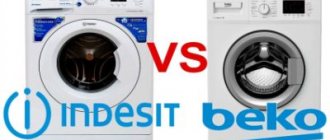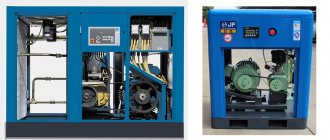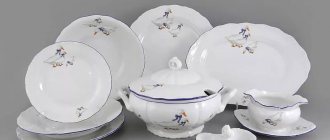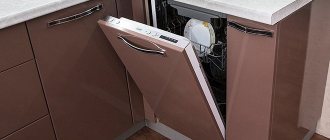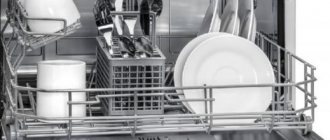Purchasing dishwashing equipment will reduce water consumption and free the housewife from manual work. When choosing a dishwasher for their kitchen, buyers will learn that devices are divided into narrow (45 cm) and full-size (60 cm). Information about the features of each type of machine will help you find the right option.
- Which dishwasher to choose: narrow or wide
- Advantages and disadvantages of the 45 cm machine
- Pros and cons of 60 cm wide models
- Catalog of dishwashers with reviews
The main differences between 45 and 60 cm dishwashers
Recently, narrow, small-sized dishwashers have become increasingly popular, but they are clearly not able to displace standard-sized machines. Models 45 cm wide have the following features:
- can be built-in or independent;
- have quiet inverter motors;
- hold no more than 10 sets of dishes;
- have 4-5 work programs;
- utensil boxes can be adjustable or non-adjustable;
- the cost of models is 25-35 thousand rubles;
- there are delay timers, smart sensors and an economical mode;
- consume approximately 9 liters of water per cycle;
- have child protection and automatic shut-off mode;
- consume a small amount of electrical energy;
- will look harmonious in the overall design and are suitable for open kitchens.
Of course, we can talk about more detailed characteristics when considering this or that model, but the parameters of these models are really good. Such machines are suitable for fairly large families or bachelors, because many of them have a half-load option. As for 60 cm dishwashers, they will be more expensive in terms of cost, can accommodate 13-14 sets of dishes, and consume up to 15 liters per cycle. It seems that it is not economical for the home at all, but modern models have become more advanced in terms of functionality and are economical, so you can pay attention to them. Of course, the dimensions of standard dishwashers are quite large and before buying them for a regular kitchen, you should think about whether there will be room there to simply turn around.
Who should choose which one?
Which dishwasher is better—45 or 60 cm—is determined by the size of the kitchen and the number of family members.
Models 45 cm
A 45 cm dishwasher is better suited for a family of 4 people. It holds approximately 10-12 sets of dishes, and is also built into the kitchen set without any modifications to the design.
60 cm models
The machine, stationary or built-in, can accommodate 16 sets of dishes at 60 cm. It will be able to provide clean dishes for a family of 6 people. With the available half-load function, such equipment can handle smaller volumes of dishes without wasting water and electricity, however, wide models are demanding on space.
45 cm dishwashers – advantages, disadvantages and who should buy them
Whether a 45 cm or 60 cm dishwasher is better can be discussed only after a basic review of both options has been completed, and the appropriateness of using one or another model in a particular case has been clarified. If we talk in more detail about dishwashers 45 cm wide, then it is worth noting that they have many advantages, among which it is worth noting the following:
- take up little space in the kitchen, but are quite spacious inside;
- have the same set of programs as standard size machines;
- look stylish and modern;
- There are many built-in models, which allows you to choose the most optimal option for a specific kitchen;
- operate virtually silently, consume little water and electricity;
- have full or partial protection against leaks, children and overheating;
- have adjustable boxes, which allows for high-quality washing of any kitchen utensils;
- there are built-in smart sensors that allow you to regulate the processes of washing, rinsing and drying, as well as select the most optimal operating mode;
- you can buy a pretty good model for 25 thousand rubles.
Manufacturers have learned to make machines that are compact in appearance, quite spacious, and equipped them with the best innovative options that provide excellent performance, which is an excellent option for the home. For small kitchens, bachelors or small families, such options will be ideal, but for those who often receive a huge number of guests or have their own business related to the food industry, it is worth buying larger, more powerful models.
The disadvantages of such machines may be that some models are not very well thought out and, indeed, hold very little or have poor leak protection, but this all depends on the model and brand and, if you look carefully, you can find the ideal model.
Advantages and disadvantages of the 45 cm machine
Fornelli BI 45 KASKATA Light S
The main advantages of narrow models are the following:
- The compact machine will fit well into the set, regardless of the type of installation, and will not take up much space. If necessary, choosing a furniture façade will not be difficult.
- Dishwashers with a cabinet width of 45 cm are purchased more often than full-size ones. Therefore, manufacturers respond to existing demand and offer a large selection of narrow models.
- This equipment has the full functionality of full-size devices.
Users consider the disadvantage of compact models to be the small capacity of the hopper (up to 10 sets), namely:
- inability to wash large dishes;
- the need for additional launch after receiving guests.
A number of manufacturers produce narrow machines with an improved volumetric chamber that can accommodate up to 12 sets of dishes. However, not everyone needs a large bunker. Russian buyers are increasingly purchasing a car for a family of 1-2 people in order to free up personal time for more interesting activities than washing dishes.
If we compare narrow models with full-size ones, experts believe that the service life of 45 cm dishwashers is on average 2 years less. This is explained by the gradual wear of parts due to their close location in a small case.
Criterias of choice
Before buying, first of all, they evaluate the scale of the “problem” - where to put the machine and how to connect it. The choice will depend on this.
If the kitchen is of modest size, then every centimeter is sometimes worth its weight in gold - a full-sized 60 cm model may not fit into a small kitchen. The choice is clear - you need to buy a narrow machine.
What to do if there is plenty of space? Which technique is better - 45 or 60 cm wide? You will have to focus on the main selection criteria:
- Number of household members and frequency of receiving guests. This determines the intensity and frequency of washing. If a lot of dishes get dirty, then the hopper should be spacious and only a full-size model can take on such a load.
- Features of dishes. If you have to wash not only cups and spoons, but also frying pans and baking sheets, capacity is important, which a narrow machine cannot boast of.
- Economical use. If you are used to saving on electricity and other resources, a small dishwasher may be suitable. Why “may” and not 100% fit? - you ask. It’s simple: the consumption of water and electricity depends not only on the size of the housing, but also on the functionality of the PMM.
- Ergonomics of the bunker. We are talking about the way the baskets are arranged inside the washing chamber. The more thoughtful the internal design and the more convenient it is to adjust the baskets, the better the washing and the easier the process of loading and unloading dishes. This saves time and detergents. This parameter is also reflected in capacity. Even baking sheets can fit into a hopper with adjustable boxes, and then even large dishes can be washed in a narrow PMM.
- Software arsenal. The more useful options, the better. And the point is not in the large number of programs, but in such useful additions as delayed launch or half-loading. With such functions, the machine works more economically.
- Noisy. If the decibels emitted by the equipment exceed the 55 mark, it is better not to take such equipment - it will be noisy in the kitchen. The ideal range is 45 to 52 dB. If you find a model that makes noise at 40-42 dB, you'll hit the jackpot.
- Mark. The brand plays a role in the choice. Buyers hold German equipment in high esteem, while the least favorite is domestic equipment. What about Chinese units? Asian brands provide good competition even to famous companies. Therefore, the demand for equipment from Eastern countries is somewhere in the center of the ranking.
- Leakage protection. There are options with partial or full protection. The more secure you are from a flood (and your neighbors too), the more peace of mind you (and your neighbors) will have.
You have familiarized yourself with the main list of factors on the basis of which you should make a purchase. Not every one of the listed criteria will help you decide which car to choose - 45 or 60 cm, but if you look at it as a whole, a completely understandable picture emerges. However, read the review further and you will understand which size is preferable.
Dishwashers 60 cm - advantages, disadvantages, for whom they are suitable
Dishwashers with a width of 60 cm are considered standard and belong to the category of equipment for the home, but they can also be used in small cafes. These models are quite large in size, are not always economical in terms of water consumption and electricity consumption, and are quite expensive. As for the advantages of using these particular options for kitchen appliances, they are as follows:
- can accommodate up to 14 place settings;
- there are special baskets with clamps for fragile cutlery, spoons and forks;
- there is a large functional range;
- there are automatic functions that allow you to select the most optimal washing mode and turn off the device without human intervention;
- the machines have a reliable body;
- standard models are equipped with new inverter motors that operate virtually silently;
- new economical generation dishwashers have appeared on sale, using even 10 liters of water per cycle;
- most models have full protection against leaks and children;
- standard machines have a convenient warning system, displaying information on the floor using a beam;
- you can turn on even a half-loaded machine, which is very convenient in standard home conditions.
Of course, not everyone can afford a 60 cm dishwasher and there is not always enough space for it in the kitchen, but still, this option is considered to be more professional and, indeed, this is true.
For small families or bachelors, this option is not suitable at all, it will consume unnecessary electricity and take up a lot of space, but in places where it is always noisy and a whole mountain of dirty dishes accumulates, this is exactly the kind of dishwasher that is needed.
Pros and cons of 60 cm dishwashers
Full-size dishwasher models have a lot of advantages noted by users:
- The volumetric chamber allows you to wash an average of 14-18 sets in one cycle, including large-diameter pots and pans. If necessary, if very few dirty items have accumulated, you can turn on the half-load mode, if provided by the manufacturer.
- The free arrangement of dishes in the baskets promotes good circulation of water in the hopper and high-quality cleaning of all items.
Housewives consider the only disadvantage of a 60 cm dishwasher to be that it takes up a lot of space. It is more difficult to install a full-size model than a narrow one. Since standard furniture modules will not fit, you will have to make a cabinet or a whole set to order.
Whirlpool WFO 3T222 PG X
If installation is not difficult, a dishwasher with a wide body will become an indispensable assistant in the daily routine of a large family.
Today, the household appliances market offers a variety of dishwashers for every taste, but limited space forces one to choose a narrow device, which has advantages: the machine easily fits into the interior of the kitchen and makes the housewife’s life easier. The full-size model requires finding a large free niche in the room, but it will be useful for a family that uses a huge amount of dishes and large utensils every day.
The best dishwashers 45 and 60 cm - how not to make a mistake with your choice
If a person has already assessed for himself all the pros and cons of the 45 and 60 cm dishwasher options, knows what parameters he needs, then he will not miss the choice of model. Of course, German-made dishwashers are the ideal choice, but there are other worthy options. Among the standard and small-sized dishwashers that really deserve the attention of consumers, it is worth noting the following models:
- Electrolux ESL94201LO
(width 45 cm, consumes 9.5 liters per cycle, has full protection against leaks and holds 9 sets of dishes). - Hotpoint-Ariston HSIC 2B27 FE (the width is 45 centimeters, there are 5 operating modes, it can accommodate 9 sets of dishes, there is full protection against leaks and there is a half-load option).
- Siemens IQ100 SR615X83NR (a narrow machine designed for 10 sets, has a very stylish appearance, there is a delayed start and half loading, there is an automatic door closer that works if it is not closed properly. There is a smart washing program that informs the person about the execution of operations beam on the floor).
- Bosch Silence Plus (has the lowest possible noise level, will look good in a kitchen combined with a living room, consumes little energy and consumes 8.5 liters of water per cycle, holds nine sets of dishes, and also has a delay start timer, width is 45 cm).
- Bosch series 2 SMV25AXO3R (standard dishwasher 60 cm, has a quiet inverter motor, consumes 9.5 liters of water per cycle, has a half-load option, has five programs and a delay start of up to 9 hours).
- AEG FSR52610Z (consumes 10 liters of water per cycle, has a width of 60 cm and an affordable price, and the door, after completing the washing process, opens automatically. The dishwasher is equipped with smart sensors, operates quietly, checks the purity of the water, it can load 13 sets and has special compartment for fragile glass and porcelain. There is a delay start timer and complete protection against leaks).
- Hotpoint-Ariston HIO 3C23 WF (the machine is 60 cm wide, has a record low noise level, can fit 14 sets of dishes. You can adjust the height of the boxes, which allows you to load different dishes, there are 9 high-quality washing programs and a self-cleaning option, as well as a delay start).
Principle of operation
The process of working as a kitchen assistant can be divided into several successive stages.
- Putting dishes in the machine. Selecting the desired program.
- Filling the tank with water, heating it and softening it.
- Detergent supply.
- Spraying water on dishes, removing dirt.
- Draining dirty water, new purification.
- Rinsing dishes.
- Drying.
Narrow PMM 45 cm: pros and cons
Let us briefly highlight the main advantages and disadvantages of narrow models.
- Compact and ergonomic. The point is not even in saving free space, but in the optimal placement of PMM in the kitchen, especially small-sized ones. The smaller the machine, the more appropriate it looks in the interior. You can easily integrate a narrow model into a kitchen cabinet, even if you choose a non-built-in option - just install it in a cabinet of a suitable size.
- Large selection and variety of models. We will return to this issue in detail in the main part of the review with examples of models. But in general, the statistics of marketing specialists are such that 45 cm cars are bought many times more actively than usual, and if there is demand, then the market undoubtedly has supply.
- There are no problems with the selection of the facade. Taking into account the previous point about the popularity of narrow modifications, it is much easier to choose a furniture façade for a narrow PMM. Often the door for wide devices is made to order, and this is unnecessary gestures.
- Saving 15 cm of free space in the room.
The pros are clear, but what about the cons? There are no less of them:
- Not all utensils fit into the bunker. Baking dishes, large pots, baking sheets - all this can simply go into the sink for hand washing. The dishwasher should do the washing, not you.
- Durability and manufacturability are not something the owner of such equipment can be proud of. Due to savings on the housing, the parts are located close to each other, which negatively affects their service life. As a result, cars last 2 or even 2.5 years less.
- Large families won't be happy. If at least 3 other people live with you, it is better to abandon the idea of such a purchase - the capacity of the camera will not be enough.
Narrow
Advantages:
- Compact and ergonomic design. A narrow dishwasher saves space in the kitchen and can be easily integrated into standard cabinets from most kitchen furniture manufacturers.
- Big choice. Because The demand for narrow models is great, there is more variety in the model range compared to full-size dishwashers.
- Choice of cladding. The popularity of narrow built-in dishwashers allows you to choose a facing panel with a ready-made color and texture solution. Most kitchen furniture manufacturers already have ready-made facades included in the set.
Flaws:
- Large dishes will not fit into the interior of the dishwasher. Cauldrons, duck pots, trays, baking sheets, frying pans will require manual washing or an additional run of the dishwasher.
- Lifetime. The narrow body does not allow free placement of working units. Lack of space for functional units reduces the service life of the machine by an average of a couple of years.
- A narrow PMM will not cope with a large number of dishes in 1 cycle. Using such a model for sets of dishes for 5-7 people will require additional cycles of operation, which will lead to increased consumption of electricity, water and time.
- Choosing your first dishwasher from a plethora of brands and models can be more of a challenge than purchasing and installing it.
Pros and cons of full-sized PMMs
We've sorted out the narrow structures. In principle, this is where we can end the review. But there are nuances that should be clarified about standard machines. Their main advantages are:
- Roomy. Standard includes up to 14 sets, there are options with a hopper and for 16 sets of dishes.
- Excellent washing quality. This is not related to software or other characteristics. It's simple: the more freely you arrange the dishes, the better they will wash.
- Economy modes. Often small dishwashers do not have such a useful option as half load. Even if you load half of the bunker into them, the same amount of resources will be spent. Full-fledged models have a lot of programs that allow you to save water, electricity and detergents.
There are disadvantages, but they relate exclusively to the size - it is difficult to fit the unit into a small kitchen.
Full size
Pros:
- Capacity. Along with the plates, you can load a saucepan, baking sheet or frying pan into the sink. A wide dishwasher can wash more than 16 sets of dishes in one cycle.
- Washing quality. There is no need to place dishes crowded due to the larger internal space, which has a positive effect on washing all surfaces and hard-to-reach places.
- Economical. Despite their large dimensions, modern wide machines are equipped with a half-load mode, which allows you to regularly wash dishes without waiting for the hopper to be filled, and without wasting additional water and electricity.
Minuses:
- Difficult to install. In a small room, it can be difficult to allocate 60 cm of space for a full-size dishwasher.
- Difficult to embed. Standard cabinets are designed for narrow cars. The frame will have to be made to order.
- Difficulty in cladding. There are almost no ready-made solutions, which forces the user to order the production of a façade panel separately.
General installation recommendations
To use your dishwasher correctly, it is important to comply with all requirements regarding its installation.
When installing any dishwasher model, it is important to pay attention to the following points:
- you need to select a suitable location in advance, taking into account the dimensions of the device, the length of the hose and electrical wire. This will speed up the installation process and will allow you to use the dishwasher correctly in the future;
- it is necessary to ensure the availability of the necessary communications (water supply and drainage, separate outlet). The socket must be grounded;
- It is not recommended to install the dishwasher under the hob or near heating radiators.
If you have already installed a dishwasher, but still do not understand its technical capabilities, then watch the instructions on how to use the dishwasher in videos posted on the Internet, or read on.
Comparative characteristics of models
Let's compare narrow and full-size cars from different brands in terms of characteristics and cost. User reviews also play an important role - we made a selection of models based on the points awarded by the Yandex.Market rating. As “guinea pigs” we took proposals from the world famous Siemens brand.
Siemens built-in dishwashers
| iQ100 SR 64E072 | iQ100 SN 614X00 AR | ||
| Width, in centimeters | 44,8 | Width, in centimeters | 59,8 |
| Hopper volume, in cookware sets | 10 | Hopper volume, in cookware sets | 12 |
| Energy consumption classes, washing, drying | A/A/A | Energy consumption classes, washing, drying | A/A/A |
| Control type | Electronics | Control type | Electronics |
| Display | Eat | Display | No |
| Water consumption, in liters | 9,5 | Water consumption, in liters | 11,7 |
| MAX power consumption, kW | 2,4 | MAX power consumption, kW | 2,4 |
| Noise, dB | 48 | Noise, dB | 52 |
| Washing modes | 4 | Washing modes | 4 |
| Drying type | Condensation | Drying type | Condensation |
| Leakage protection type | Yes, full | Leakage protection type | Yes, full |
| Beam on the floor | Eat | Beam on the floor | Eat |
| Cost, in rubles | From 23 866 | Cost, in rubles | From 28 900 |
Freestanding dishwashers from Siemens
| iQ100 SR 215W01 NR | SN 236I00 ME | ||
| Width, in centimeters | 45 | Width, in centimeters | 60 |
| Hopper volume, in cookware sets | 10 | Hopper volume, in cookware sets | 13 |
| Energy consumption classes, washing, drying | A/A/A | Energy consumption classes, washing, drying | A++/A/A |
| Control type | Electronics | Control type | Electronics |
| Display | No | Display | Eat |
| Water consumption, in liters | 9,5 | Water consumption, in liters | 6,5 |
| MAX power consumption, kW | 2,4 | MAX power consumption, kW | 2,4 |
| Noise, dB | 48 | Noise, dB | 44 |
| Washing modes | 5 | Washing modes | 6 |
| Drying type | Condensation | Drying type | Condensation |
| Leakage protection type | Yes, full | Leakage protection type | Yes, full |
| Cost, in rubles | From 24 860 | Cost, in rubles | From 48 850 |
If in the case of built-in units, efficiency is determined by dimensions, then with stationary PMMs, price often decides everything. Expensive freestanding equipment turned out to be more economical than a cheaper similar narrow machine and a full-sized built-in car wash. This only confirms that the savings are not so much in size as in manufacturability. So, by choosing a 45 cm technique, you will only save space and money. It is worth deciding what you are going to save - finances, free space or resources, and, based on this, make a choice.
Manufacturers
Dishwashing machines have foreign roots. Thanks to reviews, you can navigate brands and make the right choice.
The most popular brands that meet the standard in all respects are:
- BOSH . It is compact and affordable. They often have a program that protects against leakage.
- ELECTROLUX . Equipped with protection to prevent water seepage. Can hold about 5 sets of dishes.
- SIEMENS . The cost of dishwashers from this manufacturer is much higher, but along with the price, the quality of washing also increases.
This is an incomplete list of manufacturers that you should focus on when choosing.
When shopping for a dishwasher, don’t forget to think about:
- Which model - built-in or regular - suits your kitchen size?
- What size according to the number of sets do you need?
- What programs will you use and what type of control do you like best?
User reviews
After researching thematic forums, we selected user reviews that reflect the advisability of purchasing a 45 or 60 cm machine.
Tatiana, Moscow
I raved about being a dishwasher for two years. But I didn’t want to take a narrow or compact one, I was waiting until I moved to an apartment with a large kitchen. And so it happened: buying an apartment, moving, dishwashing - I already knew what size I needed, I took a full-size 60 cm. I use it once a day, or even every other day or on half mode. Really EVERYTHING goes in - even a leaf from the oven. I don’t know what would fit in a car at least 10 cm smaller.
Oleg, Sochi
My wife has been wanting a dishwasher for a long time. We have a small kitchen, and I thought for a long time about how to solve this problem. As a result, I moved the washing machine into the bathtub (also narrow, “Whirlpool”), and installed a PMM in its place. Even the space has become larger - you can’t put anything on the washing machine, because it’s a lid, but here we immediately put a kettle and a toaster. It’s upsetting that I can’t wash particularly large dishes, but I help my wife with this issue in my free time. The rest is cleaned 5 points - the glasses squeak, the plates are clean and without streaks. I can’t say which is better, 45 or 60 cm, because there are no analogues yet.
Of course, a couple of opinions is not enough to form your own. But in general, it is clear that buying a 45 cm machine is beneficial if you have limited space in the kitchen. Otherwise, it is inferior to full-size PMMs.
Varieties
When choosing a dishwasher, you should keep in mind that they differ in both design and placement in the kitchen.
There are three types of this technique:
- Built-in . It is almost invisible in the kitchen. Such designs are simply built into your furniture, so such devices are practically invisible from the outside.
- Free standing equipment. You can place this device in a place convenient for you.
- Compact . Due to its small size, this dishwasher can easily fit on a table or other free space.



